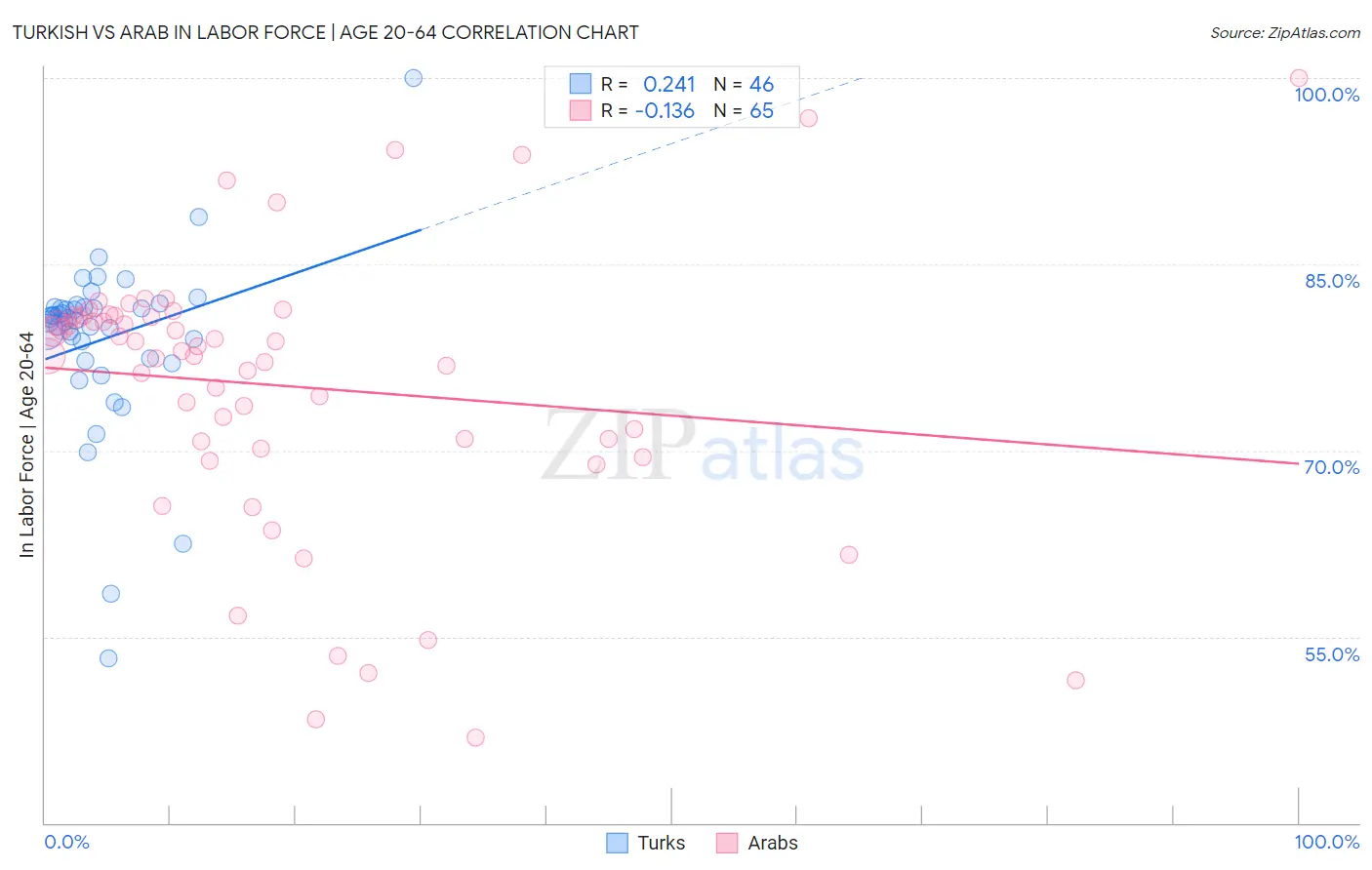Turkish vs Arab In Labor Force | Age 20-64
COMPARE
Turkish
Arab
In Labor Force | Age 20-64
In Labor Force | Age 20-64 Comparison
Turks
Arabs
80.3%
IN LABOR FORCE | AGE 20-64
99.2/ 100
METRIC RATING
52nd/ 347
METRIC RANK
79.2%
IN LABOR FORCE | AGE 20-64
11.4/ 100
METRIC RATING
216th/ 347
METRIC RANK
Turkish vs Arab In Labor Force | Age 20-64 Correlation Chart
The statistical analysis conducted on geographies consisting of 271,859,072 people shows a weak positive correlation between the proportion of Turks and labor force participation rate among population between the ages 20 and 64 in the United States with a correlation coefficient (R) of 0.241 and weighted average of 80.3%. Similarly, the statistical analysis conducted on geographies consisting of 486,876,166 people shows a poor negative correlation between the proportion of Arabs and labor force participation rate among population between the ages 20 and 64 in the United States with a correlation coefficient (R) of -0.136 and weighted average of 79.2%, a difference of 1.4%.

In Labor Force | Age 20-64 Correlation Summary
| Measurement | Turkish | Arab |
| Minimum | 53.3% | 46.9% |
| Maximum | 100.0% | 100.0% |
| Range | 46.7% | 53.1% |
| Mean | 79.0% | 75.2% |
| Median | 80.6% | 78.0% |
| Interquartile 25% (IQ1) | 77.4% | 70.4% |
| Interquartile 75% (IQ3) | 81.5% | 80.8% |
| Interquartile Range (IQR) | 4.1% | 10.4% |
| Standard Deviation (Sample) | 7.2% | 11.1% |
| Standard Deviation (Population) | 7.1% | 11.0% |
Similar Demographics by In Labor Force | Age 20-64
Demographics Similar to Turks by In Labor Force | Age 20-64
In terms of in labor force | age 20-64, the demographic groups most similar to Turks are Immigrants from Sri Lanka (80.4%, a difference of 0.020%), Immigrants from Peru (80.3%, a difference of 0.020%), Peruvian (80.3%, a difference of 0.030%), Immigrants from Sudan (80.4%, a difference of 0.040%), and Immigrants from Cabo Verde (80.3%, a difference of 0.050%).
| Demographics | Rating | Rank | In Labor Force | Age 20-64 |
| Slovenes | 99.7 /100 | #45 | Exceptional 80.5% |
| Immigrants | Pakistan | 99.6 /100 | #46 | Exceptional 80.5% |
| Immigrants | Africa | 99.6 /100 | #47 | Exceptional 80.4% |
| Immigrants | Hong Kong | 99.5 /100 | #48 | Exceptional 80.4% |
| Immigrants | Greece | 99.4 /100 | #49 | Exceptional 80.4% |
| Immigrants | Sudan | 99.4 /100 | #50 | Exceptional 80.4% |
| Immigrants | Sri Lanka | 99.3 /100 | #51 | Exceptional 80.4% |
| Turks | 99.2 /100 | #52 | Exceptional 80.3% |
| Immigrants | Peru | 99.2 /100 | #53 | Exceptional 80.3% |
| Peruvians | 99.1 /100 | #54 | Exceptional 80.3% |
| Immigrants | Cabo Verde | 99.0 /100 | #55 | Exceptional 80.3% |
| Immigrants | Northern Africa | 99.0 /100 | #56 | Exceptional 80.3% |
| Afghans | 98.9 /100 | #57 | Exceptional 80.3% |
| Serbians | 98.9 /100 | #58 | Exceptional 80.3% |
| Swedes | 98.9 /100 | #59 | Exceptional 80.3% |
Demographics Similar to Arabs by In Labor Force | Age 20-64
In terms of in labor force | age 20-64, the demographic groups most similar to Arabs are Immigrants from Armenia (79.2%, a difference of 0.010%), Immigrants from Norway (79.2%, a difference of 0.010%), Immigrants from Western Asia (79.2%, a difference of 0.010%), Irish (79.3%, a difference of 0.030%), and Immigrants from Portugal (79.3%, a difference of 0.030%).
| Demographics | Rating | Rank | In Labor Force | Age 20-64 |
| Bangladeshis | 16.4 /100 | #209 | Poor 79.3% |
| Haitians | 16.1 /100 | #210 | Poor 79.3% |
| Europeans | 15.3 /100 | #211 | Poor 79.3% |
| Irish | 13.2 /100 | #212 | Poor 79.3% |
| Immigrants | Portugal | 12.8 /100 | #213 | Poor 79.3% |
| Immigrants | Armenia | 12.2 /100 | #214 | Poor 79.2% |
| Immigrants | Norway | 12.0 /100 | #215 | Poor 79.2% |
| Arabs | 11.4 /100 | #216 | Poor 79.2% |
| Immigrants | Western Asia | 11.0 /100 | #217 | Poor 79.2% |
| Immigrants | England | 9.3 /100 | #218 | Tragic 79.2% |
| French Canadians | 8.4 /100 | #219 | Tragic 79.2% |
| Immigrants | Immigrants | 7.7 /100 | #220 | Tragic 79.2% |
| Hungarians | 7.2 /100 | #221 | Tragic 79.2% |
| Immigrants | Panama | 6.9 /100 | #222 | Tragic 79.1% |
| Canadians | 6.8 /100 | #223 | Tragic 79.1% |